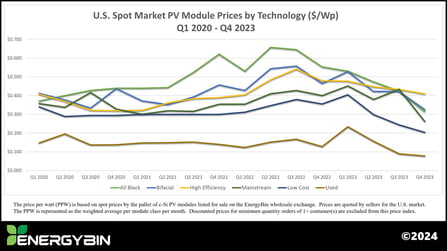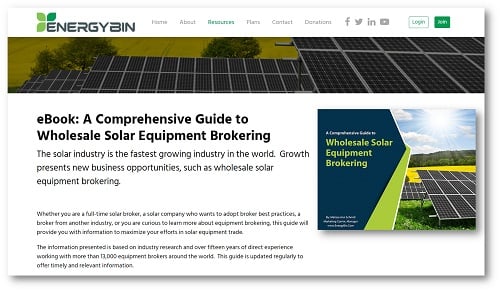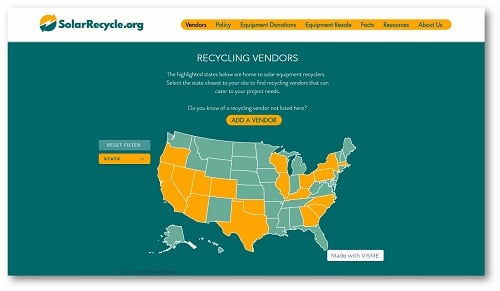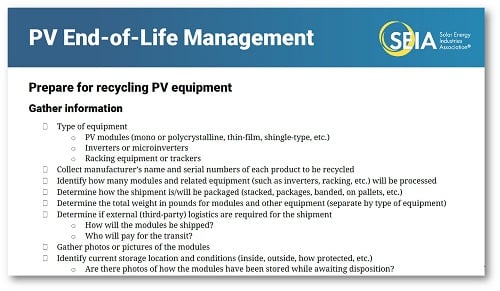The transition to renewable energy sources is booming with solar increasing at record numbers. The International Energy Agency reported 179 terawatt-hours of solar PV were added to the global energy mix in 2021, which has made solar the “lowest cost option for electricity generation in most of the world.”
But what happens to unwanted modules, inverters, batteries, racking, and other hardware as solar systems reach their end-of-life? What can EPCs and contractors do with project leftovers? What happens to allocated PV material when a project is downsized or cancelled? What if decommissioned modules and the like still have viable life to give?
The answers to these questions resides in the secondary market, where solutions for repair, resale, recycling, and even upcycling make it possible to maximize the worth of these assets. As we get the most out of what we produce, we also minimize, and in many cases eliminate, solar waste. Think of the secondary market as a place to remarket new products that fall out of the primary market or as a way to extend a used product’s lifespan. The secondary market offers an alternative to the landfill as well as opportunities to create new revenue streams via resale and value-added services.
For example, a short-circuiting inverter can be repaired to quickly get a system back online. Or, unwanted still-functioning solar panels paired with recycled EV batteries can be resold to buyers at a lower cost. Even materials extracted during the recycling process can be repurposed or upcycled for new applications.
The secondary market provides yet another platform for economical innovation to flourish, as evidenced by the resources provided in this toolkit. These resources were collected by EnergyBin to help solar companies and asset owners connect to secondary market solutions.
The toolkit will be continually updated as new resources present themselves. If you have a solution for PV repair, resale, or recycling not included on this list, please contact the author.
Repair
1. Solar component testing devices
What it offers:
This Solar Power World article provides an overview of five tools – an infrared camera, a digital multimeter, a clamp meter, an insulation tester, and a battery analyzer – to troubleshoot, diagnose, and confirm repairs on components within operating solar systems. Regular component testing can prevent power outages, and routine maintenance can prolong hardware performance. In addition to prevention, these tools accurately help to diagnose problems, which leads to efficient repair.
Why we like this resource:
It’s a quick read that lays out exactly what you need to accurately test, diagnose, and confirm solar component repairs. Pay attention to the author’s recommendation to purchase tools that meet CAT safety ratings for enhanced personal safety when working on or near electrical equipment.
2. Repair tape for cracked backsheets
What it offers:
DuPont Photovoltaic Solutions released a new Tedlar-based repair tape. The purpose of the tape is to repair cracked backsheets at a fraction of the cost of panel replacement. Faulty modules can be dismounted in the field by a trained service provider, fixed on-site, and remounted. Or, they can be shipped to a repair center. The solution works for any kind of backsheet and has been tested on severely cracked surfaces. In the 2020 DuPont global PV reliability report, which tracks component degradation, module failures in the field, and backsheet durability, researchers found a four-fold cumulative increase in polyvinylidene fluoride outer-layer cracking defect rates from 5-23% between years 4-9 after installation. Other backsheet materials that show premature degradation include polyamide and polyethylene terephthalate.
Why we like this resource:
The repair tape can be applied to any type of backsheet. The ability to apply the tape in the field can save time and money. The simple application process provides an alternative to replacing modules, which may be hard to find.
3. Flowable silicon sealant for degrading backsheets
What it offers:
A team of researchers from DOW Chemical Company published results on a new flowable silicone sealant that fills backsheet cracks with an insulating material. The sealant has been proven to restore insulation resistance as well as provide a protective layer against subsequent degradation. This solution is appropriate for all types of backsheets, including polyamide AAA backsheets. Initial tests indicate that the sealant is effective in short-term applications; however, long-term testing is needed particularly regarding moisture penetration. Yet, silicone sealants tend to be reliably durable, which is why manufacturers use them for frame sealing and junction box bonding.
Why we like this resource:
Because it can be applied in the field, this solution may be a lower cost option than module replacement or off-site repair.
4. Basic solar panel and inverter repair information
What it offers:
In these two basic guides – Solar Inverter Repair and Solar Panel Repair – The Enphase O&M Marketplace powered by 365 Pronto talks about maintenance frequency, warranty protection, factors to consider regarding repair versus replacement, estimated costs, and how to pick a qualified service provider. Unless you’re a certified electrical technician, it’s not recommended that you attempt to repair a damaged module or inverter on your own. With respect to the question of whether to repair or replace, the answer tends to come down to cost and product availability. For instance, if a product model has been discontinued, it may be difficult to find an exact match replacement, and therefore, repair may be the better option.
Why we like this resource:
These guides are easy to read and provide a starting point for reviewing your options when a solar panel or inverter malfunctions. They’re written for residential and commercial solar owners as well as for asset management (O&M) companies.
5. Techniques to find replacement parts
What it offers:
This webinar provides solar companies with five techniques to find replacement solar panels and parts – Check with the manufacturer or your primary distributor, call your industry colleagues, message your social media network, conduct a smart internet search, and partner with a solar equipment broker. These techniques provide a roadmap for navigating the solar aftermarket. Having a plan of action for finding replacement parts makes this task manageable and keeps your customers happy.
Why we like this resource:
The insights provided in this webinar come from the speakers’ experience of over twenty years’ wholesale commodity trading in the secondary market. If you’ve run into a dead end trying to locate hard-to-find replacement parts, this webinar may help.
Need help connecting to a repair technician or finding a replacement part?
6. Methodology to repair glass in double-glass solar panels
What it offers:
Scientists from Utrecht University in the Netherlands are the first to develop a methodology to repair glass breakage in glass-glass solar panels. The proposed technique is adopted from the auto industry with respect to windshield repairs. The scientists published their research findings in Solar Energy Materials and Solar Cells. Initial findings conclude that the technique is a feasible and effective repair solution.
Why we like this resource:
Although this research is in the experimental stage, it's exciting to see success in an area where glass defects typically result in unsalvageable modules. This repair technique shows promise in changing solar module waste due to glass defects into repairable, reusable products.
Resale
7. PV module price index
What if offers:
This resource tracks and reports on crystalline-silicon (c-Si) module trade within the secondary market. Results are based on data collected from the EnergyBin platform, where solar companies list PV equipment for resale. The report is published annually, and spot prices quote wholesale prices by the pallet. C-Si modules are categorized by module class for easy comparison to primary market price indices.
Why we like this resource:
This price index is the first of its kind for the secondary solar market giving the industry its first real look at pricing of c-Si modules at a wholesale level, outside of the traditional distribution channel. It’s a useful resource for monitoring resale pricing trends.
8. Secondary market watch video series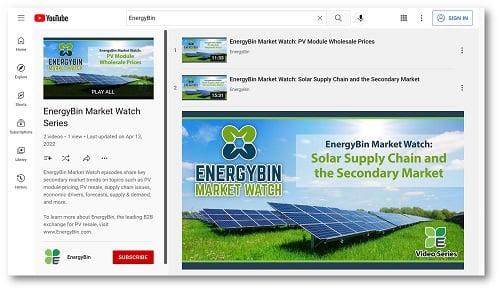
What it offers:
EnergyBin Market Watch episodes share key secondary market trends on topics such as PV module pricing, PV resale, supply chain issues, economic drivers, forecasts, supply & demand, and more. Episodes are added every 3-6 months. The discussions pull in current industry news stories as well as case studies from solar companies who are reaping success in the secondary market.
Why we like this resource:
These videos offer a way to dive deeper into what’s going on in the ever-in-flux secondary market. We draw upon EnergyBin’s exchange data as well as success stories we hear first-hand from PV professionals who are buying and selling solar equipment in the secondary market.
9. EnergyBin Insights webinar series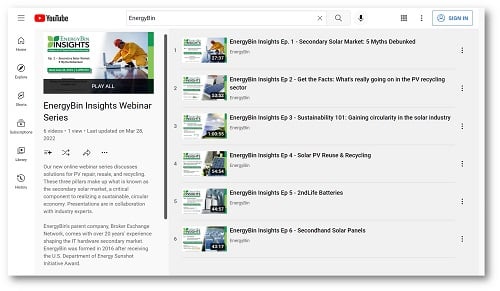
What it offers:
EnergyBin Insights is a webinar series that discusses solutions for PV repair, resale, and recycling with industry experts. Key topics include:
- Secondhand: How used solar panels help people and the planet
- What you need to know about second-life batteries for solar systems
- Solar PV reuse & recycling: How human behavior affects the fate of aging solar panels
- Sustainability 101: It’s time for a new mind to gain circularity in the solar industry
- What’s really going on in the PV recycling sector
- Secondary solar market: 5 myths debunked
- And more...
As the EnergyBin community is committed to accelerating a robust and sustainable secondary market, these webinars seek to provide the general public with relevant and timely information to propel the market forward in this direction.
Why we like this resource:
This webinar series is the only program of its kind dedicated to secondary solar market solutions. Industry professionals turn to this resource for fresh ideas and to identify new business opportunities. If you have a solution for PV repair, resale, or recycling that you’d like us to consider for a webinar episode, please contact the author with a topic proposal and presentation outline.
10. Refurbish or recycle – what to do
What it offers:
In this resource, SunCast interviews Fabtech Enterprises, an industry expert specializing in end-of-life management solutions, including used solar module resale via their sister company, SanTan Solar. The podcast episode approaches the conversation of what to do with an end-of-life PV array from a practical business perspective and what opportunities exist in the resale and recycling sectors for entrepreneurs. Fabtech works with large-scale solar operators to decommission and appropriately dispose of system components.
Why we like this resource:
This podcast episode presents the challenge of managing solar waste in a positive light. Opportunities exist for new businesses to move into this space. This resource highlights companies and organizations who are filling the business model gap to address end-of-life management.
11. Guide to wholesale solar equipment brokering
What it offers:
This guide extensively covers wholesale solar equipment brokering as an emerging and necessary opportunity in the solar industry. It showcases a number of business models that EnergyBin has witnessed first-hand in the industry today. The guide also includes best practices, case studies, and additional resources by sub-topic. The information presented is based on industry research and over twenty years of experience working with buyers and sellers who trade wholesale equipment.
Why we like this resource:
This guide is a compilation of many resources. It’s easy to navigate and click through to more information on a specific topic, such as surplus liquidation or secondhand solar panels. The guide is regularly updated with more resources, making it a centralized source for information on buying and selling solar equipment in the secondary market.
Recycling
12. SolarRecycle.org
What it offers:
This resource offers a directory of solar PV recycling vendors located in the United States. Search by state, or find a recycling vendor that meets your project needs. The website is managed voluntarily by a group of industry peers. It also provides up-to-date information on policy, equipment donations, equipment resale, facts, and a list of more resources. Having a centralized information hub for PV recycling plays a critical role in connecting solar waste to recycling facilities. We don’t want to see end-of-life equipment going to landfills.
Why we like this resource:
This website is well-known within the industry for providing reliable and timely information about the PV recycling market in the U.S.
13. Best practices at the end of the PV performance period
What it offers:
The National Renewable Energy Lab (NREL) provides best practices for alternatives – extending the performance period, refurbishing, repowering, or decommissioning the PV system – when a PV system reaches the end of its performance period. The paper also reviews laws that can limit these options. More and more regulations are popping up to require the proper handling, storage, and final disposition of PV waste as an effort to keep material out of landfills. NREL discusses how the industry is turning liability into new business opportunities, such as the resale of used modules and parts, decommissioning, and recycling. To help system owners, asset managers, and industry service providers plan for the end of a PV project lifecycle, NREL provides financial scenarios and cost estimates for each alternative.
Why we like this resource:
This paper provides detailed analyses of the four alternatives at the end of the performance period – extending the performance period, refurbishing the system, repowering the system, and decommissioning. The authors make clear that the end of the performance period may not necessarily be the end-of-life of the hardware itself, and therefore, alternatives can lead to resale and/or donating. The cost estimates are helpful to incorporate in the early stages of project planning.
14. PV recycling checklist
What it offers:
The Solar Energy Industries Association (SEIA) offers a PV end-of-life management checklist to help system owners and asset managers prepare for recycling PV equipment, specifically all types of modules, inverters, racking equipment, and trackers. These insights were compiled by members of the National PV Recycling Program, a group of SEIA members who are committed to responsible end-of-life management practices. Shipping the material is a major factor in the EOL process. The authors note that it’s not recommended to send a shipment without coordination and notification. Follow the checklist for a seamless process.
Why we like this resource:
This resource provides a 2-page bullet point list of thoughtful considerations one should take when planning to sunset their PV system. It’s clear and concise while detailing specifics for gathering information, choosing a recycling partner, preparing documentation, and arranging shipping logistics.
15. End-of-life management of solar panels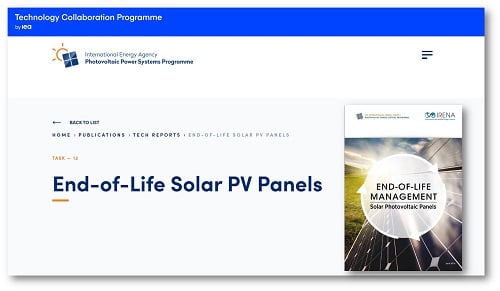
What it offers:
The International Renewable Energy Agency (IRENA) and the International Energy Agency’s Photovoltaic Power Systems Programme (IEA-PVPS) published this report in 2016 to address the economic potential of the global PV recycling sector. The authors call for the adoption of effective PV-specific waste reduction, the expansion of existing waste management infrastructure, and the promotion of on-going innovation. The report examines a number of untapped business opportunities as decommissioned solar panels enter the waste stream.
Why we like this resource:
This report is the first of its kind to publish global projections that are widely cited in the solar industry today. It includes an extensive overview of the European Union’s progress in meeting PV-specific collection, recovery, and recycling targets. As the world’s most mature solar market, the EU has been leading the way in establishing effective regulations that encourage PV recycling.
16. Upcycling silicon PV waste into thermoelectrics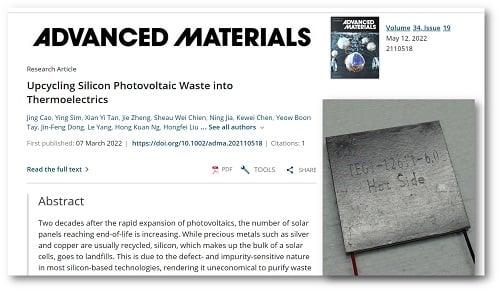
What it offers:
A research group of scientists from the National University of Singapore, Nanyang Technological University, and the Agency of Science, Technology, and Research has discovered a technique to take recycled silicon from solar modules to reuse in thermoelectric devices. Current PV recycling processes have yet to determine how to economically extract purified silicon from old modules. Most silicon-based technologies are impurity-sensitive. Yet, thermoelectric devices prove to be the exception. The new technique pulverizes polycrystalline silicon into powder and pelletizes it into ingots. Reported results indicate improved power factor and carrier scattering as well as improved electronic and thermal transport properties with an attractive energy harvested per dollar ratio (as compared to conventional thermoelectrics).
Why we like this resource:
This research provides a key solution for upcycling solar waste and thus realizing a circular economy. Although this technique is currently in the research stage, it offers a glimpse of what’s to come, hopefully in the near future.
Put these resources into action
The purpose of this toolkit is to inform and inspire. These resources inform the reader of secondary solar market solutions in practice today that maximize the value of PV equipment and minimize waste. Secondary market solutions propel the advancement of solar energy adoption throughout the world.
These resources inspire ongoing innovation in the areas of PV repair, resale, and recycling, which leads to a robust and sustainable secondary market and contributes to the overall development of a circular economy within the solar industry.
Use this toolkit to learn about what’s going on in the secondary market, connect to solution providers, and discover new business opportunities. Revisit this list as new resources are added. Contribute to this list by submitting your solutions for PV repair, resale, and recycling to the author.



